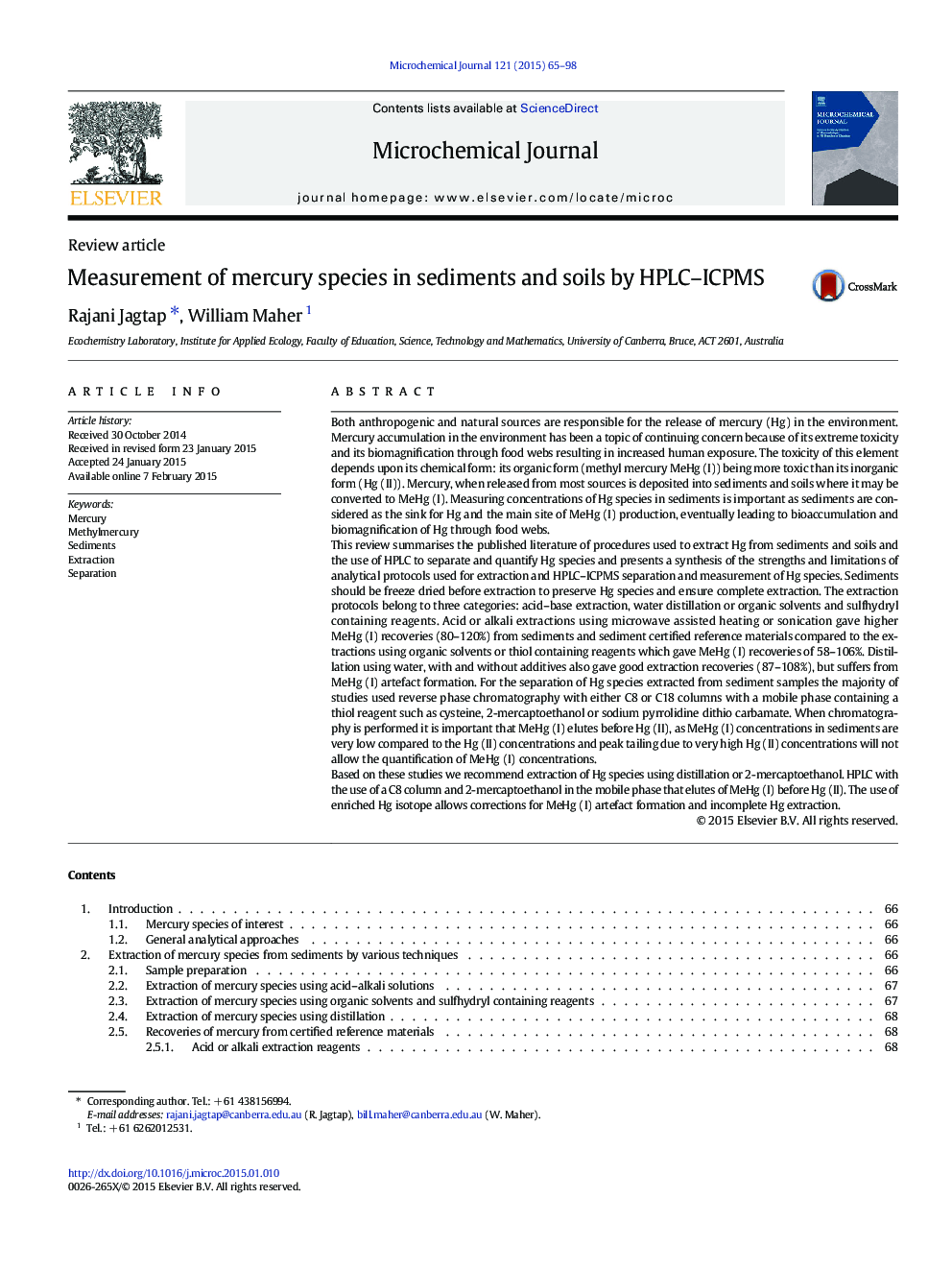| کد مقاله | کد نشریه | سال انتشار | مقاله انگلیسی | نسخه تمام متن |
|---|---|---|---|---|
| 1227671 | 1494873 | 2015 | 34 صفحه PDF | دانلود رایگان |

• Protocols for measurement and separation of mercury species in sediments by HPLC–ICPMS are reviewed.
• Methyl mercury can be extracted using acid–base, organic solvents and thiol containing reagents.
• Extraction and separation using 2-mercaptoethanol are recommended.
• Mercury species in the extract can be separated using C8 and C18 reverse phase chromatography.
• Use of isotope dilution is recommended for evaluating extraction efficiencies and artefact formation.
Both anthropogenic and natural sources are responsible for the release of mercury (Hg) in the environment. Mercury accumulation in the environment has been a topic of continuing concern because of its extreme toxicity and its biomagnification through food webs resulting in increased human exposure. The toxicity of this element depends upon its chemical form: its organic form (methyl mercury MeHg (I)) being more toxic than its inorganic form (Hg (II)). Mercury, when released from most sources is deposited into sediments and soils where it may be converted to MeHg (I). Measuring concentrations of Hg species in sediments is important as sediments are considered as the sink for Hg and the main site of MeHg (I) production, eventually leading to bioaccumulation and biomagnification of Hg through food webs.This review summarises the published literature of procedures used to extract Hg from sediments and soils and the use of HPLC to separate and quantify Hg species and presents a synthesis of the strengths and limitations of analytical protocols used for extraction and HPLC–ICPMS separation and measurement of Hg species. Sediments should be freeze dried before extraction to preserve Hg species and ensure complete extraction. The extraction protocols belong to three categories: acid–base extraction, water distillation or organic solvents and sulfhydryl containing reagents. Acid or alkali extractions using microwave assisted heating or sonication gave higher MeHg (I) recoveries (80–120%) from sediments and sediment certified reference materials compared to the extractions using organic solvents or thiol containing reagents which gave MeHg (I) recoveries of 58–106%. Distillation using water, with and without additives also gave good extraction recoveries (87–108%), but suffers from MeHg (I) artefact formation. For the separation of Hg species extracted from sediment samples the majority of studies used reverse phase chromatography with either C8 or C18 columns with a mobile phase containing a thiol reagent such as cysteine, 2-mercaptoethanol or sodium pyrrolidine dithio carbamate. When chromatography is performed it is important that MeHg (I) elutes before Hg (II), as MeHg (I) concentrations in sediments are very low compared to the Hg (II) concentrations and peak tailing due to very high Hg (II) concentrations will not allow the quantification of MeHg (I) concentrations.Based on these studies we recommend extraction of Hg species using distillation or 2-mercaptoethanol. HPLC with the use of a C8 column and 2-mercaptoethanol in the mobile phase that elutes of MeHg (I) before Hg (II). The use of enriched Hg isotope allows corrections for MeHg (I) artefact formation and incomplete Hg extraction.
Journal: Microchemical Journal - Volume 121, July 2015, Pages 65–98